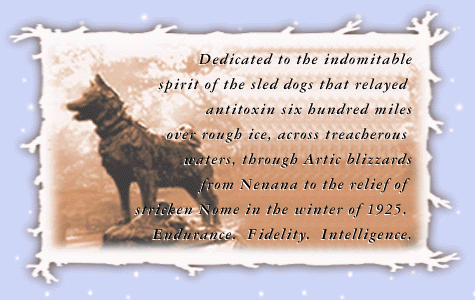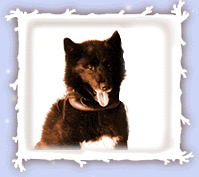

For the real-life Balto, entering Nome at 5:30 am, February 2, 1925, at the head of Gunnar Kaasen's medicine-bearing sled team was not only the end of an ordeal, but the beginning of an adventure that had a few more bizarre twists and turns before the happy ending.
For the record, Balto lead the team on the final 53-mile leg of the 674-mile "Great Race of Mercy to Nome" that saved the town from a serious diphtheria epidemic. Generally following the sled dog trail used to carry the mail from Anchorage to Nome, the sled dog team relay carried the vital serum from the rail terminal at Nenana to Nome in just under five-and-a-half days - still considered a world record by mushers today!
 Running in a fierce blizzard that had paralyzed all other means of transportation, the sled dogs and mushers faced biting winds, huge snow drifts and temperatures of minus 50 degrees. Balto nonetheless proved his worth as a leader when he stopped his team before they could blunder into the Topkok River and instant death. Further along, a sudden blast of wind lifted both team and driver into the air, and the medicine flew off the sled into the snow. After a frantic, bare-handed search, Kaasen found it and finished the run.
Running in a fierce blizzard that had paralyzed all other means of transportation, the sled dogs and mushers faced biting winds, huge snow drifts and temperatures of minus 50 degrees. Balto nonetheless proved his worth as a leader when he stopped his team before they could blunder into the Topkok River and instant death. Further along, a sudden blast of wind lifted both team and driver into the air, and the medicine flew off the sled into the snow. After a frantic, bare-handed search, Kaasen found it and finished the run.
Instantly, Kaasen, Balto and the rest of the sled dogs became heroes in the United States. The 'Heroes of Alaska' were brought to Hollywood to star in a film, Balto's Race to Nome, and they toured the country in the summer and fall of 1925. The statue of Balto in New York's Central Park commemorating the "Great Race of Mercy" that appears at the beginning of the film was dedicated at this time.
However, it was the "Roaring Twenties," and interest eventually waned. Balto and the rest of the dog team were sold to a vaudeville promoter and relegated to virtual sideshow status. It was under these conditions two years later that Cleveland businessman George Kimble, on a trip to Los Angeles, found Balto and his companions displayed in a 'dime' museum where they were kept under questionable condition.
 Remembering the story of the "Great Race of Mercy," Kimble was outraged and resolved to rescue the dogs. He struck a deal to purchase the dogs for $2,000, with just one catch; he had to have the money in two weeks! A Balto Fund was started, appealing for donations across the nation. In Cleveland, schoolchildren collected coins, their parents passed the hat, and businesses gave what they could.
Remembering the story of the "Great Race of Mercy," Kimble was outraged and resolved to rescue the dogs. He struck a deal to purchase the dogs for $2,000, with just one catch; he had to have the money in two weeks! A Balto Fund was started, appealing for donations across the nation. In Cleveland, schoolchildren collected coins, their parents passed the hat, and businesses gave what they could.
In just ten days, Kimble was able to proclaim, "City Smashes Over Top With Balto Fund! Huskies To Be Shipped From Coast At Once!"
On March 19, 1927, Balto and his six companions once again led a procession down a city street, but this time it was a parade in their honor through Cleveland's Public Square. They were then taken to live at the Cleveland Zoo, where more than 15,000 people visited them that first day.
After years in the happy and dignified setting, Balto died on March 14, 1933, at the age of 11.
Back in Alaska, the "Great Race of Mercy to Nome" is remembered and memorialized today with the grueling dog sled race over the Iditarod Trail the full 1,049 mile mail route from Anchorage to Nome.
|
|
|
